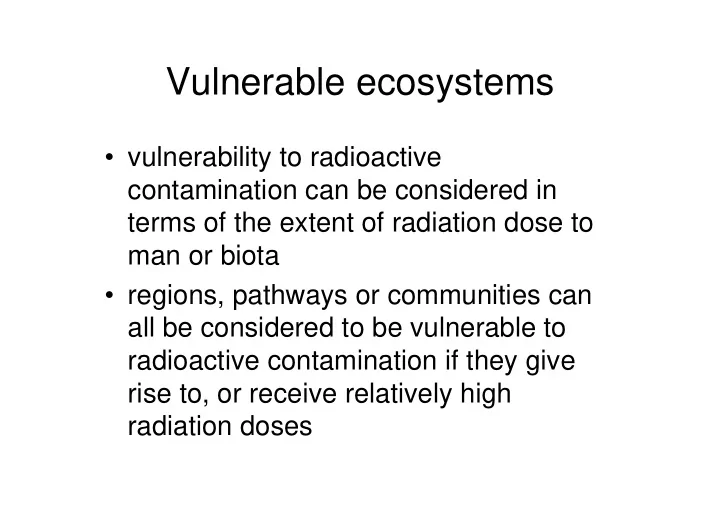

Vulnerable ecosystems • vulnerability to radioactive contamination can be considered in terms of the extent of radiation dose to man or biota • regions, pathways or communities can all be considered to be vulnerable to radioactive contamination if they give rise to, or receive relatively high radiation doses
Vulnerability - changes with time • long effective Mushrooms ecological half-lives Upland sheep Potatoes for 137 Cs 1 0.1 n terrestrial animals 0.01 inhabiting areas with 1E-3 organic soils 1E-4 1E-5 n mushrooms 1E-6 1E-7 1E-8 1E-9 1E-10 0 20 40 60 80 100 Year
Vulnerability - quantification l SPECIFIC l FLUX • specific activity • total Bq output in (Bq/kg) in a product a product (Bq) – predicted using – needs estimates deposition, of production or transfer rates of coefficients and harvesting effective ecological half- lives
Vulnerability -Spatial analysis • compiling variation in food production and harvesting rates • mapping the distribution of food products, especially wild foods • quantification of transfer, relevant to soil type and species • incorporating changes with time in contamination of important foodstuffs
Vulnerable areas or groups • proximity to potential sources • high precipitation rate • high milk production rate dominance of “small” animals • presence of semi-natural ecosystems – organic soils, forests • special groups, with high consumption rates of contaminated products – mushroom foragers, game consumers
Vulnerability Generalizations can mask high individual exposure Consideration of vulnerability at a small spatial scale can improve estimates of: l collective dose l individual dose l provide guidance on uncertainities
Vulnerability - emergency response • prior studies of vulnerability and its spatial and temporal variation can identify areas, and types of foods which would be contaminated above intervention limits • Identification of vulnerable areas, combined with contamination maps can guide monitoring and implementation of countermeasures
Exposed groups • General public – collective and individual doses • Special groups – individual doses • users of semi-natural ecosystems, eg hunters, mushroom foragers, upland dairy goat smallholders • people who eat/drink large quantities of home- grown produce, including milk (eg smallholders)
Vulnerable areas • Vulnerability can be considered in a variety of ways, including: – high activity concentrations in different food products – high total fluxes of radiocaesium – special population groups with high radiocaesium intake rates • Conversely, resilient areas are those where the impacts of radiocaesium deposition are low The identification of areas producing
Ecosystem variation • Agricultural ecosystem – potentially important for all mobile radionuclides – short ecological half-lives • Semi-natural ecosystems – important mainly for radiocaesium – inherently more variable than agricultural systems – long ecological half-lives
Vulnerability -Spatial analysis • compiling variation in food production and harvesting rates • mapping the distribution of food products, especially wild foods • quantification of transfer, relevant to soil type and species • incorporating changes with time in contamination of important foodstuffs
Action or Critical loads • The amount of radionuclide deposition necessary to produce radionuclide concentrations in food products exceeding intervention limits for areas used in the production or harvesting of foodstuffs • Action load– short term (surface) • Critical load – mid-long term
Additional critical loads for 137 Cs in arctic systems -2 ) 160 Cs-137 Critical additional load (kBq m 120 80 40 0 0 25 50 75 100 137 Cs deposition (kBq m -2 ) Global fallout
Vulnerable areas or groups • proximity to potential sources • high precipitation rate • high milk production rate & dominance of “small” animals • use of semi-natural ecosystems – organic soils, forests • special groups, with high consumption rates of contaminated products – mushroom foragers, game consumers
Vulnerability - emergency response • prior studies of vulnerability and its spatial and temporal variation can identify areas, and types of foods which would be contaminated above intervention limits • Identification of vulnerable areas, combined with contamination maps can guide monitoring and implementation of countermeasures
Action or Critical loads • Potential method of addressing issues of vulnerability to radionuclide contamination • Can be defined as the amount of radionuclide deposition necessary to produce radionuclide concentrations in food products exceeding intervention limits for areas used in the production or harvesting of foodstuffs
Additional critical loads -2 ) 160 Cs-137 Critical additional load (kBq m Moose 120 80 Cow milk 40 Reindeer 0 0 25 50 75 100 137 Cs deposition (kBq m -2 ) Global fallout
UK aspects • Identification of vulnerable areas • Injection of realism • Importance of public reassurance • Setting up of working groups involving stakeholders • extension of emergency exercises for longer times
Vulnerability assessment Contamination Environmental Biota transfer exposure Aggregated transfer coefficient (m 2 kg -1 ) Intervention Production / limit (Bq kg-1) harvesting Diet / social habits Flux Food (Bq y -1 ) distribution Action loads ManSv (Bq m -2 ) Dose coefficients Individual exposure of humans (mSv Bq -1 m 2 )
Recommend
More recommend